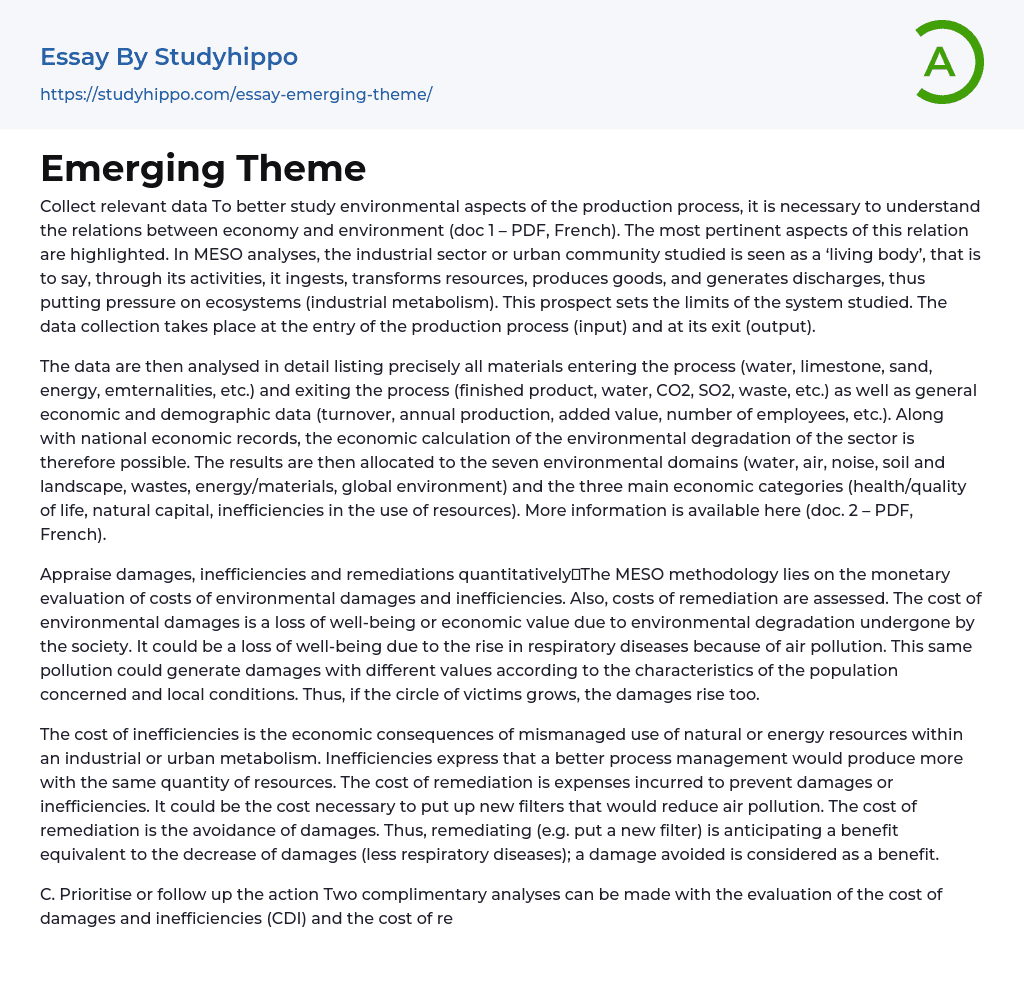To study the environmental aspects of the production process effectively, it is important to gather relevant data. Understanding the connection between the economy and the environment is crucial (doc 1 – PDF, French). The most important aspects of this relationship are highlighted. In MESO analyses, the industrial sector or urban community being studied is considered as a 'living body'. This means that through its activities, it consumes resources, transforms them, produces goods, and creates waste, thereby impacting ecosystems (industrial metabolism). This approach determines the scope of the system being studied. The collection of data occurs at the input and output stages of the production process.
The information is then carefully analyzed, detailing all the materials involved in the process (water, limestone, sand, energy, externalities, etc.) and the outputs from the process (finished product, water, CO2, SO2, waste, etc.), as wel
...l as general economic and demographic data (turnover, annual production, added value, number of employees, etc.). This allows for the calculation of the environmental degradation caused by the sector, along with national economic records. The results are categorized according to seven environmental domains (water, air, noise, soil and landscape, wastes, energy/materials, global environment) and three main economic categories (health/quality of life, natural capital, inefficiencies in the use of resources). For more information, refer to this document (doc. 2 – PDF, French).
The MESO methodology includes the quantitative evaluation of damages, inefficiencies, and remediation costs. Damages are the negative impacts on well-being or economic value caused by environmental degradation, such as increased respiratory diseases due to air pollution. The severity of damages can vary depending on population and local conditions. Inefficiencies refer to the economic consequences o
mismanaged natural or energy resources, where better process management could result in greater output without using additional resources. Remediation costs are the expenses incurred to prevent damages or inefficiencies, like implementing new filters to reduce air pollution. Remediation is considered a way to avoid damages and brings benefits equal to the reduction in damages, such as a decrease in respiratory diseases.
To prioritize actions or track progress, two analyses can be conducted: evaluating the cost of damages and inefficiencies (CDI) and assessing the cost of remediation (CR). To determine prioritization, calculate the ratio between CDI and CR. This ratio indicates how cost-effective a remediation approach is. For example, if the ratio is 2, it means that for every 1 dinar invested in remediation efforts, there is an avoidance equivalent to a loss of well-being worth 2 dinars.
The calculated environment-economic profiles help make decisions regarding which remediation measures should receive priority attention.The text discusses the importance of determining whether to invest in various environmental factors such as air pollution, soil, water, or better management of inefficiencies in the cement sector. These determinations aid in comparing different sectors and specializing in environmental protection. The damages and costs of remediation help regulate economic sectors differently. From a theoretical perspective, these findings provide insight into the optimal pollution level where additional investment in depolluting does not yield benefits. The accompanying graph illustrates the environment-economic profile for any economic sector. The data indicates that investing one dinar in improving energy and material management can prevent double the amount of damages. However, when it comes to the water sector, investing in remediation has minimal impact with a nearly zero return for each
dinar spent (with a ratio close to 1).
- Energy Development essays
- The elements essays
- Voltage essays
- Solar Energy essays
- Nuclear Energy essays
- Alternative Energy essays
- Environment Pollution essays
- Plastic Pollution essays
- Electronics essays
- Computer Science essays
- Consumer Electronics essays
- Enterprise Technology essays
- Hardware essays
- Robot essays
- engineering essays
- people search essays
- Modern Technology essays
- Impact of Technology essays
- Cloud Computing essays
- Operating Systems essays
- Information Technology essays
- Data Analysis essays
- Information Age essays
- Smartphone essays
- Cell Phones essays
- Camera essays
- Computer essays
- Ipod essays
- Mobile Phones essays
- 3g essays
- Bluetooth essays
- Cell Phones in School essays
- Computer File essays
- Desktop Computer essays
- Servers essays
- Data collection essays
- Graphic Design essays
- Data Mining essays
- Cryptography essays
- Internet essays
- Network Security essays
- Android essays
- Computer Security essays
- World Wide Web essays
- Website essays
- Computer Network essays
- Application Software essays
- Computer Programming essays
- Computer Software essays
- Benchmark essays




